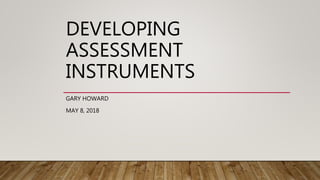
Gary howard developing assessment instruments
- 2. BACKGROUND • Learning centered assessment tasks are expected to function as learning events • Learning centered assessments are to be criterion-referenced – that is they should be linked to instructional goals and performance objectives • Test items should be in one to one correspondence with performance objectives – in other words – only assess what you teach 2
- 3. OBJECTIVES • Describe the purpose for criterion-referenced tests • Describe how entry skills tests, pretests, practice tests, posttests are used by instructional designers • Name four categories of criteria for developing criterion-referenced tests and list several considerations within each criterion category • Given a variety of objectives, write criterion-referenced, objective-style test items that meet quality criterion in all four categories • Develop instructions for product development, live performance, attitude assessments, develop rubrics for evaluating learners’ work • Evaluate instructional goals, subordinate skills, learner and context analysis, performance objectives, and criterion-referenced test items for congruence 3
- 4. FOUR TYPES OF CRITERION-REFERENCED TESTS AND THEIR USES • There are four types of tests the designer may create: • The Entry Skills test • The Pretest • The Rehearsal • Practice Test 4
- 5. ENTRY SKILLS TESTS • Entry skills tests are given to learners to determine that they possess the Pre- requisite skills to begin instruction 5
- 6. PRETESTS • Pretests are administered to determine previous mastery 6
- 7. PRACTICE TESTS • Practice tests are used during instruction • They offer feedback during the instruction 7
- 8. POSTTESTS • Posttests are summative testing to determine over all effectiveness of instruction 8
- 9. TEST DESIGN • Intellectual skills domain objectives are more complex • Higher order skills are harder to access • Attitudinal domain skills require the learner to express preferences • Psychomotor domain objectives may require learners to perform a sequence of steps to demonstrate an acquired skill 9
- 10. MASTERY LEVELS TESTING • Mastery level performance is usually that expected of the best learners • If students can guess then the designer should include multiple questions on the mastery skill in question 10
- 11. TEST ITEM FORMAT AND PERFORMANCE OBJECTIVES • Test item selection should be objective driven. • Completion items include identifications and definitions • Short answer, matching, and multiple choice require selection, and evaluation and discrimination among other skills • Essays require discussion and demonstration of developments of concepts • Excellent for illustrating mastery level skills acquisition 11
- 12. OBJECTIVE TESTS • Objective tests are easy for learners to complete and for designers to score. • Includes completion, short answer, true/false, matching and multiple choice. • All tests should include clear, concise directions. 12
- 13. ALTERNATIVE ASSESSMENT INSTRUMENTS FOR PERFORMANCES, PRODUCTS, AND ATTITUDES • Directions must guide the learners activities • Testing for Attitudes require more consideration for more covert testing • Designer should develop checklists, ratings scales and a medium for frequency counts 13
- 14. PORTFOLIO ASSESSMENTS • Provides an opportunity to evaluate change over time exhibited in a learners work samples • It is very time consuming and expensive 14
- 15. CONGRUENCE IN THE DESIGN PROCESS • In the systems approach to instructional design, it is important to evaluate the design periodically • Requires all materials produced so far for completion of design evaluation • Four main criteria for evaluating the overall design are: • goal, learner, context, and assessment criteria 15
- 16. CONGRUENCE IN THE DESIGN PROCESS, CONTINUED. FIVE PROCEDURES FOR EVALUATING THE DESIGN • Organize and present the materials to illuminate their relationships 16
- 17. CONGRUENCE IN THE DESIGN PROCESS, CONTINUED. FIVE PROCEDURES FOR EVALUATING THE DESIGN • Judge the congruence between the information and skills in instructional goal analysis and materials created 17
- 18. CONGRUENCE IN THE DESIGN PROCESS, CONTINUED. FIVE PROCEDURES FOR EVALUATING THE DESIGN • Judge the congruence between the materials and the performance and learning contexts • Judge the congruence between materials and characteristics of target learners • Judge the clarity of all materials 18
- 19. SUMMARY AS A CHANGE AGENT, REFLECTIVE PRACTITIONER AND LIFELONG LEARNER • A paradigm referenced evaluation is made out of things or execution assignments that specifically measure aptitudes depicted in at least one behavioral goals. More slender focused evaluations are to be foundation referenced. This kind of testing of test is imperative for assessing the two students; a procedure and instructional quality. Evaluation Self-Reflection Think about how you have utilized appraisals in the past to either measure your own insight and expertise levels or to investigate the aptitudes of your students. Do you feel the evaluations helped you to pick up a superior comprehension of your insight and that of your students? The capacity to modify the adapting needs with the goal that all students can get a handle on the substance and have the capacity to release the data come test time Life Long Learner: Being ready to overcome compelled circumstances that can enable me to be a superior instructor and give a valiant effort as a student too. Change Agent: The way toward learning and planning for test time 19
- 20. • GARY HOWARD • COACHGHOWARD@GMAIL.COM • APT 501 20